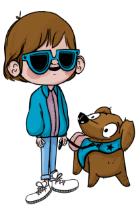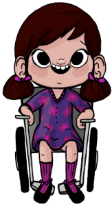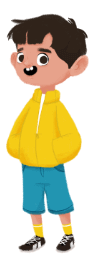My World My Way
International literary children’ s contest focused on raising awareness on persons with disabilities.
Girls and boys from 15 Latin American countries participated in its two editions and made it possible to make known and express their vision about disability through writing.
The stories were illustrated by Beatriz Calvo.

In their stories, the participants had to involve the characters proposed by Comparlante

A child with visual impairment
Visual impairment refers to the deficiency of the vision system which affects acuity and visual field, ocular motility and perception of colors and depth, resulting in diagnoses such as low vision or blindness.
He is accompanied by his guide dog: an animal specially trained to provide assistance for the mobility and independence of the visually impaired.

A girl with motor disability
Motor disability refers to a physical condition which influences the body’s ability to control and move, characterized by disturbances in the person’s movement, balance, speech, and breathing.
To facilitate her movement and autonomy, she has a wheelchair that adapts and responds to her needs.

A girl with Down Syndrome
Down syndrome is a congenital disorder derived from total or partial triplication of the chromosome 21, a cognitive spectrum disability that results in mental retardation and growth as part of certain physical changes.

A child with hearing impairment
Hearing impairment or deafness refers to the impossibility or difficulty of making use of the sense of hearing due to a loss of partial (hearing loss) or total hearing loss unilaterally or bilaterally. Like other physical disabilities, deafness can originate at birth or be acquired over the years of life.
In order to communicate, deaf people use Sign Language: a complete system of communication which, just as the spoken language allows to transmit ideas and feelings, transforming words into gestures carried out mainly with hands.

A child with autism
Autism Spectrum Disorder (ASD) is a neurodevelopmental condition characterized by the presence of alterations in 3 areas: communication, social interaction and sensory perception.
People with ASD can present behavior patterns such as restricted interests and repetitive activities, with difficulties coping with unexpected changes.

A girl with cerebral palsy
Infantile cerebral palsy (thus defined by the stage of human development where it originates) is a group of disorders that affect a person’s ability to voluntarily move in a coordinated way, maintaining balance and posture. It is the most common motor disability in childhood.
Depending on the degree of cerebral palsy, some people could make use of implements or assistive devices to assist them in mobility or other motor functions, and even in some cases, these could be totally reduced.

A girl with amputated arm or stump
Amputation is the procedure by which a part or limbs of the body (either upper: such as arms or hands, or lower: such as legs or feet) are removed through one or more bones.
There are several causes that can lead to amputation, such as traffic, domestic or work accidents, serious gunshot or explosion wounds, and those related to health conditions or congenital affections, among which diabetes stands out.
The end of the amputated limb is called a stump. Generally, people with limb loss use a prosthesis: an artificial extension that replaces the missing body part, supporting the person in carrying out daily activities and for cosmetic purposes.